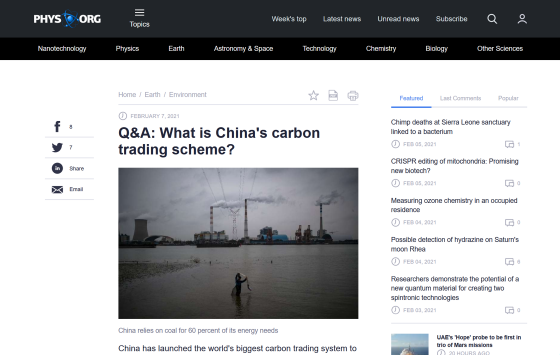China builds 'carbon dioxide emission allowance' trading system for domestic companies

On February 1, 2021, China built the world's largest carbon
Q & A: What is China's carbon trading scheme?
https://phys.org/news/2021-02-qa-china-carbon-scheme.html

The outline of this emissions trading system, which started on February 1, 2021, is that local governments set emission limits for major electric power companies, and companies purchase emission allowances from other companies that emit less carbon dioxide. To be able to do. Municipalities issue emission certificates for each ton of carbon dioxide or other greenhouse gases to each company, and if a company fails to comply with the certificate, it will pay the local government a fine.
'As the number of certificates issued by local governments decreases, the price of allowances will increase,' said Chou Jang-yu, vice president of the China Environmental Protection Fund . 'In rare cases, companies embedded in trading systems may be obliged to disclose pollution data,' Phys.org said.
September 22, 2020, 'China' to up to 2060 years in the video speech for the Xi Jinping Jintao of China is the United Nations General Assembly carbon neutral and aims to ',' was speaking . China is the world's largest emitter of greenhouse gases, accounting for 28% of the world's emissions, and it believes that carbon emissions need to be reduced by up to 90% to achieve carbon neutrality. Has been done.

A new regulation released by the Chinese Ministry of the Environment in December 2020 tells businesses to reduce carbon dioxide intensity , which is carbon dioxide emissions per energy consumption, rather than reducing total greenhouse gas emissions. I'm looking for. 'This rule looks trivial, but it's an important difference, and coal-fired power plants,' said Lauri Millibilta, chief analyst at the Center for Research on Energy and Clean Air (CREA), an air pollution research institute. Can be more economical. ' But 'China has a long-term goal of being carbon-neutral, but the current market shape will not contribute much to achieving that goal,' said Millivirta.
Related Posts:
in Science, Posted by log1p_kr







